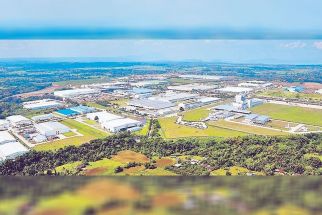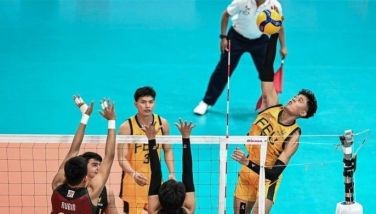Just-in-time water

Perhaps second only to power, water could turn out to be the next major headache for the government. Like power, it will be primarily about supply. But unlike power, it will be to a lesser degree about pricing.
Water though has its own unique problems, among them, drinking quality, sewer waste treatment and management, irrigation, and rights, all of which are related to ensuring the welfare and needs of people who access it.
Two projects
If there is a spot of good news that could substantially mitigate a water crisis supply especially in Metro Manila in the coming years, it is the fact that the government has started the bidding of two big projects that will help augment potential shortages.
At an estimated worth of P43 billion, the projects are being auctioned under the public-private partnership scheme. These will be the first of a number of water infrastructure projects, although both combined make up the biggest amount in the batch.
To provide the much-needed fresh water source for Metro Manila into the next decades is the P18.7-billion New Centennial Water Source project. Formerly known as the Kaliwa River and Laiban situated in Tanay, Rizal, this project will ensure potable water supply for the metro’s 12 million residents.
The second project, estimated to cost P24.4 billion, is the Bulacan Bulk Water Supply project which will provide approximately 230 million liters per day of water. Part of the project calls for the construction of a water treatment plant, water reservoir, booster pump station, water transmission mains, and the interconnection to water districts’ trunk lines.
This PPP will be a 30-year contract to build and operate the facilities of the bulk water treatment plant in Bulacan, which is an area that is now regarded as one of the fast rising urban centers north of Metro Manila.
Threats to supply
Since 1967 when Angat Dam, located 40 kilometers northeast of the metro, was first made operational by the National Power Corp. as a potable drinking water source for Metro Manila residents, as well as to provide hydroelectric power for the country, there has been no new major water infrastructure projects developed since.
With increased use of the water due to a growing population, and siltation problems affecting Angat Dam, the development of Laiban had been eyed as early as three decades ago, but had time and again encountered controversies with regards project stewardship and protests by indigenous peoples.
To date, the water supply issue has become more critical with global warming, specifically the prevalence of prolonged droughts in the northern area of Luzon, and the continued rising demand of the metropolis for clean potable water.
While the bids for Laiban supply source and the Bulacan bulk water supply projects are scheduled for awarding next year, there is no certainty that things will progress according to the latest timetable. This is, after all, the Philippines.
As this happens, Metro Manila’s two major concessionaires will be living year after year on tenterhooks not knowing whether Angat River will receive the amount of rainfall needed to be able to quench the thirst of the urban metro for clean water.
Rising water delivery cost
Meanwhile, as security of water supply continues to be threatened, the unit rate of water delivered to metro homes and business establishments has been on the rise.
This is undoubtedly the price to pay for having a more efficient and safe system of water distribution and delivery now in the hands of the private sector, as well as a dramatic improvement in sewerage management that had in the past severely affected major rivers and waterways of Metro Manila.
The privatization business model of Metro Manila where two concessionaires took over the government contract to supply water, manage the distribution system, and improve and expand their respective half zone concession areas for 25 years, is still viewed with concern by some sectors.
While Maynilad under a new management is catching up to deliver its contractual commitments, Manila Water is moving ahead to meet its coverage area obligation. Both have undoubtedly been able to raise the water quality standards as well as rehabilitate a large part water distribution channels, but at a cost.
Other challenges
Still, outside Metro Manila’s water concerns, international agencies like the United Nations continue to demand improvements on the water delivery systems outside Metro Manila held largely by local government units that are beset by financial and bureaucratic problems.
Other than that, the other remaining big water infrastructure challenge remains to be in the agriculture sector. The country’s irrigation network is badly in need of rehabilitation and expansion if it is to continue to serve farmers in rice and other food producing areas.
Ageing of irrigation canals and watersheds is further aggravated by the recent severity of typhoons and rainfall, and of course, the constant budgetary constraints of our government for infrastructure building.
At the moment, priority has been given to transport-related infrastructures – roads, bridges, and ports, and the news that water infrastructure (although focused on drinking water supply) has been given priority attention is still good news.
Prioritization
It’s understandable that an emerging economy like the Philippines is in need of so much in the face of such meager resources. As such, prioritization is an overused word that depends on the severity of need and its critical role in today’s society.
We are seeing this with regards the recent move to open funding partnerships with the private sector in the Laiban and Bulacan projects. Hopefully – and this is about all that is left with us at this point – the two projects are successfully awarded within the next year, and construction starts without delay.
Facebook and Twitter
We are actively using two social networking websites to reach out more often and even interact with and engage our readers, friends and colleagues in the various areas of interest that I tackle in my column. Please like us at www.facebook.com and follow us at www.twitter.com/ReyGamboa.
Should you wish to share any insights, write me at Link Edge, 25th Floor, 139 Corporate Center, Valero Street, Salcedo Village, 1227 Makati City. Or e-mail me at [email protected]. For a compilation of previous articles, visit www.BizlinksPhilippines.net.
- Latest
- Trending





























